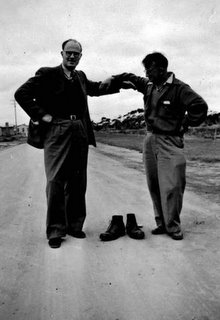
La revista Nature reporta que físicos en los Estados Unidos y Gran Bretaña han revelado el posible diseño para ropa invisible.
Explican que el material funcionaria algo como un agujero negro, doblando la luz que se pone en contacto con la prenda.
Por supuesto los ejércitos están fascinados con estos desarrollos (ver el articulo de WIRED hoy, Military Seeks Invisibility Cloak).
¡Ejercitos invisibles! ¡Crímenes imperceptibles!
Imagen: fuente
25.5.06
Ropa del futuro: ropa invisible
Publicadas por
Andrés Hax
a la/s
5/25/2006
![]()
Suscribirse a:
Comentarios de la entrada (Atom)

1 comentario:
News
Published online: 25 May 2006; | doi:10.1038/news060522-18
Invisibility cloaks are in sight
Two new recipes tell how to make objects vanish.
Philip Ball
One model of a light-bending material shows the black hole in which an object could be hidden.
© Leonhardt
Two prescriptions for an invisibility cloak have been unveiled by physicists in the United Kingdom and the United States. The researchers say that in principle the technologies needed for building these devices already exist. "Invisibility is visibly close," says Ulf Leonhardt of the University of St Andrews in Scotland, one of the researchers behind the proposals.
He and John Pendry of Imperial College London, UK, and their co-workers have independently described similar ways to create an invisible 'hole' in space, inside which objects can be hidden. They say it is possible to guide light around the hole, rather like water flowing around a rock in a river, so that the object inside it cannot be seen.
Light rays are bent when they pass between materials with different refractive indices, such as air and water. But bending light so that it passes round a region of space and emerges travelling along the same line as it was initially is a difficult trick, requiring an invisibility cloak made from materials with a 'tunable' refractive index.
Such substances have been made, in the form of so-called metamaterials. These are built from rings or coils of metal wire, etched into printed circuit boards and glued together, which act as antennae that interact with the electromagnetic field of incoming light and modify the paths the light takes. Such metamaterials can have bizarre optical properties: for example, having negative refractive index, so that they bend light the 'wrong' way.
Leonhardt and Pendry's teams have shown how in theory metamaterials with 'sculpted' optical properties could be deployed to guide light rays around an object. They report their ideas in Science1,2.
Light in the hole
This isn't the first time metamaterials have been proposed as the fabric of an invisibility cloak3 (see 'Engineers devise invisibility shield').
But in previous work, each object would need a cloak specially tailored for it. In contrast, the methods suggested by Leonhardt and by Pendry and colleagues allow anything to be hidden inside the hole.
The maths governing the behaviour of light shows that it's impossible for a material to completely evade scattering or absorbing any light whatsoever, which means it cannot be perfectly invisible.
I suspect the military is already working on it.
Ulf Leonhardt,
University of St Andrews.
But Leonhardt says that the imperfections can be made so small that they'll barely matter. "Maybe the device would create a slight haze," he says.
The ability to conceal a tank or an aircraft would obviously be welcomed by generals everywhere; current stealth aircraft simply aim to eliminate radar reflections, making them 'black' rather than truly invisible. "I have reason to suspect that the military is already working on such devices," says Leonhardt.
Dark magic
Leonhardt compares his theoretical invisibility cloak to something like a black hole: while some light rays passing close by the 'optical hole' will be bent around it, others travelling on certain trajectories would get trapped inside. The tricky bit, he says, is that one should then "gently guide the light back from the optical underworld." He says that this could be done by suitably shaping the refractive index changes of the space inside the hole, giving it properties like those of special lenses used in radar technology.
Both cloaking devices would work only for wavelengths close to the size of the individual components of the metamaterial. For visible light, this would mean that the structures would have to be fashioned using micro- and nano-engineering.
But Pendry and colleagues believe it should be possible to achieve invisibility over a reasonably broad band of wavelengths (over the entire visible spectrum, say) by embedding their 'optical hole' in a material with a high refractive index.
ADVERTISEMENT
There's no way to know yet if either design can be practically built. But Leonhardt says that Pendry's approach suggests ways to avoid some of the most demanding technical challenges of his own design. "I only just saw their paper," says Leonhardt, "and since then I am buzzing with ideas about how to combine the two different strategies."
Visit our newsblog to read and post comments about this story.
Top
References
Leonhardt U., et al. Science, advance online publication (2006) [doi:10.1126/science.1126493].
Pendry J. B., et al. Science, advance online publication (2006) [doi:10.1126/science.1125907].
Alu A.& Engheta N. . Phys. Rev., E 72. 016623 (2005).
Top
For full access to the site and the archive, subscribe here:
To receive all the daily news in your inbox each week, sign up for our email alert here:
To see the latest news visit our homepage:
http://www.nature.com/news/2006/060522/full/060522-18.html
Publicar un comentario